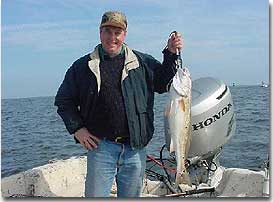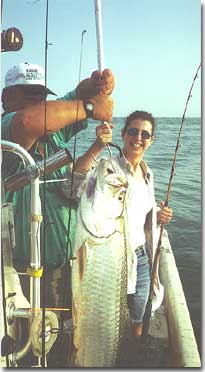The Mayport Jetties in the Summer
The Mayport Jetties in the Summer
By Jim Hammond
The Jetties, what a place to fish in the summer months.
 There is one thing that you can count on, fishing the jetties in the summer months, you will catch something. Most of the time the question is, will you get it to the boat, or do you want it in the boat. There is one thing that you can count on, fishing the jetties in the summer months, you will catch something. Most of the time the question is, will you get it to the boat, or do you want it in the boat.
Here are a few ideas and equipment, that I take with me when fishing the jetties in the summer months.
Keeping Dry:
As you all know it is that time of the year to expect a little or a lot of rain almost everyday. To be prepared for this I like to bring a Stearns rain suit or a Stearns poncho. Most of the time these showers do not last long and with a good rain suit, you can stay right there and continue to fish.
Catching your Bait:
This time of the year there are mullet and poggies everywhere. Get out you Fitec cast net and with a few throws, you can have all of the bait that you will need for a day at the jetties. These are the baits that are swimming around out there now and these are the live baits that work best now.
Keeping your Bait Alive:
If you are like me and have small live wells or you do not have a live well on the boat, you will need to rig up a live well like this.
Get a KeepAlive ROUND live well (www.keepalive.net) and hook up a KeepAlive Oxygen Infusor (www.keepalive.net) pump and a TH Marine timer switch (www.thmarine.com) to it. Once you have water in the well, you can turn this unit on and it will keep a bunch of bait alive all day without running your battery down. I have been using this system for six or seven years and I have had great success with keeping my live bait alive.
Finding the Spot:
Unless you can stick your head in the water and see what is on the bottom, you are going to need some sort of machine that will show you what is down there. A chart recorder / fish finder is what you are going to need and one that you will be very happy with the picture that it draws is the Lowrance X-15 series (www.lowrance.com). This unit comes with a black and white or color screen and both work great in direct sunlight. Having a good fish finder can sometimes make the difference in catching fish or just watching others catch um.
Rods and Reels:
I like to have several rods with me at all times, even when I sleep. The ones that I usually have on the boat when I am at the jetties in the summer are:
4 Shakespeare BWC 2202 Tiger Rods with Shakespeare TWMA 30L reels (www.shakespeare-fishing.com). These are for the big fish like tarpon, sharks and big reds, when I need to get a big bait out or on the bottom and it takes a good amount of lead to hold bottom. This outfit is sturdy enough to catch anything that swims out there. This reel gets spooled with 100 pound test (20 pound diameter) PowerPro line, a 100 pound test Sea Striker barrel swivel, a 5 to 8 ounce bank sinker, a two to three foot 80 pound mono or wire leader with a Daiichi D-18 8/0 or Daiichi Circle Wide 5/0 hook. These are the rigs that I use with my live bait.
4 Shakespeare SP 1170-1MH rods with Tidewater 3835 or 3840 spinning reels spooled with 20 pound test PowerPro. The rigs have some sort of lure that I can cast, tied to them. I like each with something different tied on. I usually have a MirrOlure 33MR in black and silver or chartreuse, a Catch 2000 in chartreuse, a 1/2 ounce Sea Striker Gotcha and a big Clark Spoon. This gives me a nice arsenal to throw at things like jacks or spanish, that might come within casting distance.
4 Shakespeare CA 3070 1MH rods with Pflueger PFL Trion 56 Baitcast reels, spooled with 20 pound test PowerPro. These outfits are for casting bigger lures like the MirrOlure 65M and 85M at larger fish like kings and tarpon. You might want a 10 to 12 inch length of wire for a leader on these.
Fly Fishing:
For those of you that like to catch-um on the fly, here is the outfit and some of the flies that I use. I start with a Shakespeare Ugly Stik BWF 110091112 fly rod in 11-12 weight. This rod is without a doubt one of toughest rods that you can purchase anywhere. These fish are not your wimpy backwater reds and trout. These great big ocean fish will DESTROY most fly rods. this is why you need a virtually indestructible rod like this Ugly Stik. The reel that I use is a Pflueger 1890 wide arbor, spooled with 13 weight line. This reel will hold about 300 yards of 30 pound test PowerPro as my backing. Why use 30 pound fly line backing that is the diameter of 40 pound mono when you can use PowerPro 30 pound test line and it is only the diameter of 8 pound mono. The flies need to be as big as you can throw. Here are a few that will work in this area:
Tools for landing a big fish:
I keep a short and medium length gaff on board for gaffing kings and LIP gaffing tarpon. I also keep a large landing net for the reds
and a pair of those orange gloves with the sticky rubber gripping stuff on the outside for grabbing tarpon by the mouth. If you catch a fish that you are not going to eat do not stick the gaff in its flesh. If you need to lift the fish for a photo, slip the gaff in its mouth or use the gloves to lift it by its mouth.
 Catching these fish:
Catching these fish:
After you have thrown your cast net for mullet in the creeks or ICW and maybe a few poggies on the beach, you are ready to get out there, get anchored and get to fishing. Using you Lowrance X-15 find a spot that has a good drop off and some small fish hanging on or near the bottom. Slip your anchor over, keeping your motor running until you get hooked up and tied off. Grab a live bait from your live well and slip the hook in its nose and out the other nostril or in this general area. Slip the bait over the side letting it go straight down. If you are fishing over rocks and you cast this rig out away from the boat, you will most likely get hung on the bottom and lose your rig EVERY TIME. I send these rigs straight down. I usually have all four of these rigs out at one time. The more baits in the water the better your chances of catching a fish. Now that you have hurried up and done all of the above, it is time to sit back and wait. All of the other poles need to be ready to throw. The baits need to be tied on and ready, because the fish that come within casting range, are not usually there for very long, so you need to be ready.
Hooking Up:
When you hook up on something nice (line is screaming off of the reel), you might want to reel all of the other rigs out of the water. I usually do this for two reasons. 1. So you do not get all tangled up with your other rigs. 2. You might have to pull up anchor and chase this fish. If this is the case you need to be ready. Do not panic and mess up, it's just a fish. If you have to chase the fish, get all of the other rigs out of the water and be sure the hooks and weights are not flopping around, get your anchor up and stored like normal.
And then, get after the fish. What was I saying, ITS JUST A FISH. This could be a fish of a lifetime.
Some of these fish have been known to head for the open ocean. Some of them act like they are headed for England. Not to worry, if you have enough food and water, you can make the trip. You might have to call home to get gas money to get back. But if everything has worked out just right, you will have caught a giant fish. So what if you're in England.
If this does happen, call your boss, so you won't be expected in for work for a couple of days.
Some of the sharks that you will hook are called spinner sharks. They should be called jumping spinner sharks because they will sometimes come out of the water several times before they break off, or you get them landed. You might want to be ready to break these off, if they look like they are going to jump in another boat.
Most of the tarpon, will have to be chased, so be ready
Some of the reds will be in the slot limit so be sure to measure them if you intend to take some home for dinner.
There are kings out there now and they do eat mullet and poggies. If you are in the right spot at the right time you might hook up on a nice king and all of these will be keepers and the last time I checked, they eat up pretty good.
Do's and Don'ts:
Do be careful. The ocean is almost always moving and this motion can get a hook buried in your flesh if you are not careful. When you store your rods, be sure that the weights and hooks are not flopping around. The sharks and kings have razor blade sharp teeth and will slice you open. Do not try to put a big shark in your boat. If you are going to keep one to eat, tie the tail to a rear cleat and leave it in the water.
|
